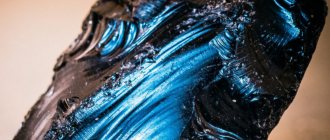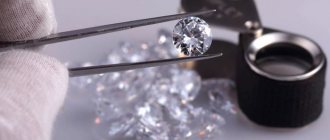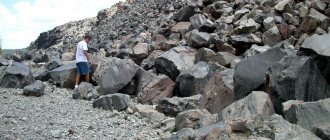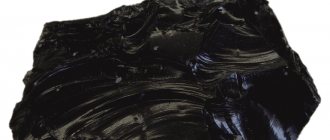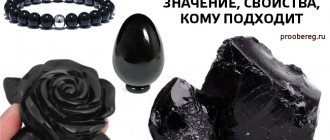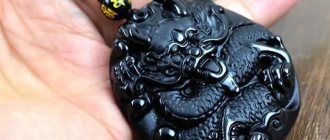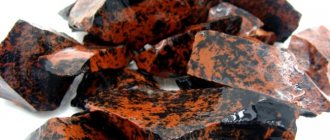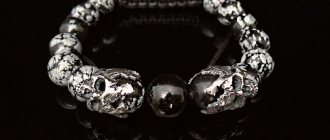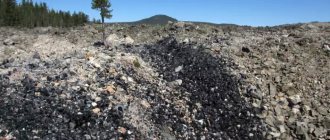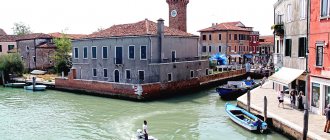origin of name
The first mentions of a unique mineral were found in Ancient Rome. They date back to the era in which the warrior Obsius lived. It was he who brought dark shiny stones to Rome from Ethiopia. The name of the warrior served as the basis for the name of the original natural mineral. Obsidian is the name given to volcanic glass.
According to another version, the name comes from the Greek word, which is translated as “vision” or “spectacle”. Ethiopian craftsmen made mirrors from this stone. Obsidian is also called vanakite, volcanic glass, Icelandic agate, Nevada diamond, wasserchrysolite, hyalite, and Montana jade.
Due to the dark color of the crystal, it was given the name “resin stone”, and because of its characteristic shine – “bottle stone”. In Russia, the name obsidian was assigned to the mineral. Latin Americans call it “Apache tears.” In Transcaucasia, it was given the name “fragments of Satan’s claws.” The places where crystals were found were called “satanidar”.
Origin of obsidian
An amazing mineral called obsidian was brought to Europe from Africa by a Roman warrior named Obsidium. Therefore, the name was given to it in honor of this man. Obsidian stone is solidified lava from a volcano that came to the surface of the earth. Its deposits are scattered throughout the globe. Volcanic glass (the second name for obsidian) is not classified as a precious gem; some jewelers do not classify it as semi-precious. However, some varieties of obsidian are more valuable than diamonds.
Stone quarrying sites
The oldest deposits of the mineral are about 9 thousand years old. It is mined in places of volcanic activity located in the territories of Ecuador and Mexico. There are rock deposits in Ethiopian, Japanese and Icelandic territories.
Crystals are mined near active and dormant volcanoes. Iridescent obsidian was discovered in the area of Hawaii and the US state of Nevada. Crystal deposits have also been discovered in Russian regions. The lands of Siberia, the Caucasus and the Kamchatka Peninsula are rich in them.
Production (field)
Volcanic glass is formed by the rapid cooling of hot igneous rocks. Most often found in areas of increased seismic activity.
Today the largest deposits are the USA, Mexico, Ethiopia, Turkey, Iceland, Armenia, Peru and Ecuador.
Russian deposits:
- Siberia;
- Transcaucasia;
- Kamchatka.
The rarest iridescent samples are mined in Nevada and Hawaii
Description of the stone
Volcanic origin determined the unique properties of obsidian. It consists of amorphous silicon oxide, which does not have a crystalline structure. Volcanic glass - obsidian - is formed from solidified lava.
It is extremely rare for crystals to be completely transparent. Most obsidians are translucent stones with a glassy sheen. They are gray, brown, black or reddish in color. Obsidian is unique in that this entire color palette is often mixed into one piece of rock.
Physical properties
| Properties | Description |
| Color | black, brown-red, gray, black-green |
| Transparency | translucent |
| Structure | non-crystalline |
| Shine | glass |
| Hardness | 6 on the Mohs scale |
| Density | 2.6 g/cm3 |
| Kink | conchoidal |
| Fragility | Yes |
| Irisation | Yes |
Applications of crystals
The main area of application of the mineral is the construction industry and industry. This is an integral part of filters. Thermal insulation materials are made with it.
Obsidian, whose price is low (for example, a ring with this mineral can cost about 600 rubles), is classified as an ornamental stone. It lends itself well to sanding. Faceted crystals are inserted into bracelets, pendants, earrings and rings. They are used to make beads and necklaces. Souvenirs are produced from pieces of rock in the form of rosaries, key rings, decorative figurines, vases and glasses.
Varieties of obsidian
The most amazing volcanic glass is snow obsidian - a black pebble with grayish-white specks. The pattern on its surface looks like snowflakes. Rainbow stones are considered expensive crystals. They are cast in reddish, greenish and blue-blue colors.
The color of these specimens when cut is similar to a drop of oil. Silver stones have grayish tints and a steely sheen. Transcarpathian black obsidian is little known. Its distinctive features are deep black tones and beautiful shine.
In addition, there are stones in white-gray, brown, red and yellow shades. The crystals are often so dark that they appear opaque and black. Translucent stones that have a greenish-brown or yellowish-brown color are usually cut.
Persians include brown crystals with black inclusions. Black volcanic glass with scattered spherulites or with radial intergrowths formed by grayish-whitish feldspar fibers is mined in the American state of Utah. This original spherulite structure is formed by partial devitrification.
Chemical composition
Chemical formula – MgO, SiO2, Fe3O4 (volcanic glass).
The chemical composition of the mineral is similar to granite, which contains feldspar - up to 65%, mica - up to 10%, quartz - up to 35%, in addition, biotite and hornblende make up 5% of the structure.
The composition contains the following list of components:
- SiO2 – 70%;
- Al2O3 – 18%;
- Na2O – 6%;
- Fe3O4 – 4%;
- CaO – 3%;
- MgO – up to 2%.
The magic of obsidian
The key property of pebbles is the ability to cleanse the human body from the inside and fill it with cosmic energy. Obsidian amulets must be treated with great care. After all, the volcanic origin of the rock brought it closer to the power of the Universe.
The secrets of the universe are revealed to the owners of the crystal. Thanks to the mineral, aggressiveness disappears and causeless worries disappear. People who have a stone endure difficult life trials more easily. They make vital decisions with a cold heart.
They are not afraid to make radical changes throughout their lives. To make drastic changes, you should wear an amulet with volcanic glass for some period. Fears and worries will recede, allowing you to make adjustments to your life plans.
This crystal is considered a talisman for practicing magicians and natural scientists. Having concentrated with its help, magicians go into the astral plane, pull the spirits of all the elements to their side, subjugating their power to themselves.
Obsidian is also a savior stone. Charms and amulets with it prevent negative actions, suppress aggressive states, increase concentration, help sharpen the sharpness of thought, eliminate tension, and show the owner his shortcomings.
Who is obsidian suitable for?
Let's consider the compatibility of the stone with zodiac signs and names.
Which zodiac signs are obsidian suitable for?
Obsidian, like other minerals, has its favorites and those it does not favor.
Aries avoid rash decisions and actions related to concluding commercial transactions and investing money. But the help of obsidian is limited to this. Constantly wearing it is strictly contraindicated for Aries: it increases nervousness, hot temper and stubbornness.
Taurus is also not recommended to use obsidian: it enhances their negative qualities. Regular use of the mineral will turn Taurus into a hysterical, impossible person.
In obsidian, Gemini found their friend, adviser and helper - this is their stone. It helps get rid of indecision, eternal hesitation and tossing from side to side. Obsidian also takes care of the material well-being of its owner.
Cancers into a manically preoccupied person who is cautious and cautious to the point of absurdity. Obsidian is strictly contraindicated for this zodiac sign.
Leos cope with attacks of pride and grandeur; it is indicated for constant wear. This mineral becomes a friend and helper for them, as well as for Gemini.
for Virgos : it turns them into suspicious and suspicious individuals, and also takes them away from reality into the world of dreams. However, short-term use of the stone will help Virgos overcome shyness and reveal their sexuality.
Libra in any way. It can be used to make decisions regarding choosing a partner and marriage: it will eliminate indecision and eternal hesitation.
For Scorpios, the stone helps control emotions and eliminates impulsiveness. He helps this “devilish” sign improve his personal life and not scare away a potential partner. But you need to use it carefully so as not to turn into a narcissist and an inveterate egoist.
For Sagittarius , obsidian helps in intellectual creative work, stimulates thought flow and mental activity.
For Capricorns , obsidian helps them radically change and turn their lives 180 degrees for the better. For them, this is a very favorable mineral; perhaps Capricorns can be called obsidian’s favorites.
For Aquarius, the stone helps to disguise negative character traits, streamline the flow of thought, and sharpen intuition. Obsidian also helps to reveal the magical gift of representatives of this zodiac sign.
Pisces get rid of the fear of change and achieve their goals. However, obsidian is not recommended for constant wear.
Combination by name
The stone reveals its positive properties for people with the names:
- Novel;
- Ilya;
- Daria;
- Anastasia;
- Tatiana;
- Natalia.
The stone helps these people choose the right path in life and not turn into the path of sin. Obsidian gives men fortitude, willpower and patience. No adversity in life can break them.
Compatibility of volcanic glass with zodiac signs
The mineral gets along well with all zodiac signs. But it is ideal for those born under the sign of Aquarius, Aries, Leo, Scorpio and Capricorn. The volcanic glass framed in silver frames shows benevolence, not hostility, towards its owners. The photo, as a rule, represents jewelry in silver, and not in gold or platinum - metals that obsidian cannot tolerate.
Not only jewelry serves as a talisman; pyramids made of obsidian are very effective (they are carried with you, put in a purse, or placed on a desk). It is believed that such pyramids are not just a souvenir, they are excellent accumulators of cosmic energy. It accumulates in them very quickly and in huge quantities.
How to distinguish from a fake
Externally, obsidian resembles minerals such as morion and rauchtopaz. Sometimes their difference cannot be noticed with the naked eye. In this case, in order to distinguish the original from the fake, you will have to turn to the help of professionals, because with a microscopic study it is easy to determine what kind of crystal you have: obsidian is an amorphous mineral, and morion and rauchtopaz are crystalline.
The healing power of obsidian
Using the stone, the body is cleansed at the cellular level. Hindus consider black obsidians to be purifying stones. They cope with cleaning low vibrations, freeing the physical body, removing negative manifestations, and dissolving “energy jams.”
Magic balls are made from volcanic glass to reveal the future. Energy charging of the body is performed by placing crystals in the navel or groin area. Pebbles laid along the central line of the body align the energy of the meridians. The effect of the mineral is enhanced by rock crystal. Obsidian in tandem with it removes mental and emotional blocks.
Crystals heal colds and mental disorders. They strengthen the immune system and regenerate reproductive functions. This is an effective remedy for restoring the reproductive system of women and men. Rainbow volcanic glass leads to normal kidney function, digestive system and blood pressure. For this purpose, jewelry or crystal is constantly carried with you.
Wounds heal faster if a volcanic stone is applied to them. Thanks to this unique feature of the mineral, surgical operations are more successful, because many instruments for performing them are made from obsidian.
Originally from Pectusan?
In the continental part of the Far Eastern region, “archaeological” obsidian is represented by volcanic glass hyalomelanes
. The bedrock outcrops of these rocks on the surface, forming primary sources, are found on only two plateaus - Shkotovsky in the south of Primorye and Obluchnenskoye in the Middle Amur region. The crusts of quenched pillow lavas and their individual fragments, formed 12-22 million years ago, are made of volcanic glass here. When destroyed, they produce a large amount of debris, which can be carried away by water flows and settle in river sediments, forming secondary sources.
Volcanic glass pebbles are a permanent component of the riverbed material of the Shkotovsky Plateau, where today, as in ancient times, one can collect an excellent collection of “glass” samples. As for the rivers of the Obluchnensky plateau, the swampiness of the floodplain and the absence of pebble spits here, even within the basalt cover, predetermined the weak distribution of this obsidian in the archaeological sites of the Amur region.
However, in the south of Primorye, objects made of obsidian with a chemical composition unusual for this territory were also discovered (Popov et al., 2005). The geological age of this glass turned out to be less than 2 million years - but in local indigenous sources, by that time the formation of obsidians had long ended. A 37-year-old story related to Pectusan, the only volcano in continental East Asia that was active in our era, helped unravel the origin of the unique samples.
The main sources of basaltic obsidians - pillow lavas and hyaloclastites - are formed as a result of the outpouring of basaltic melt into an aquatic environment or glacial strata; in nature they are always found together. Pillow lava, erupted underwater, is a collection of rounded bodies in the form of “pillows” pressed into each other. Hyaloclastite is a product of lava crushing, consisting of acute-angled fragments of volcanic glass (hyalomelane) and crystallized minerals. Modern volcanoes are unique natural laboratories: they allow us to present a complete picture of how pillow lavas and hyaloclastites were formed in ancient geological eras. Currently, these processes are occurring on the Kilauea volcano (Hawaii Island, USA), where basaltic lava flows reach the open sea. Relatively recently - in the spring of 2010 - a subglacial basaltic eruption of the Eyjafjalajökull volcano (Iceland) occurred.
This volcano is located 200 km from the southernmost point of the Russian Far East, right on the border of China and the DPRK. Judging by the data of North Korean geologists, on the southern slopes of Pektusan there are numerous bedrock outcrops of obsidian rocks, the formation of which occurred precisely in the period 0.6–2.2 million years ago (Popov et al., 2005). However, due to the difficult political situation, Russian scientists have so far only been able to visit the northern (Chinese) side of the volcano. Fortunately, the Institute of Archeology and Ethnography SB RAS (Novosibirsk) preserved two samples of obsidian from the Pektusan area, donated by North Korean archaeologists to Academician A.P. Okladnikov during his visit to their country in 1974.
The study found that Korean obsidian artifacts belong to the same geochemical group as some South Coastal tools. It is surprising that the fragments of volcanic glass from the Chinese side of the volcano differ markedly in chemical composition from the “Korean” obsidian, and the “Chinese” glass in its properties turned out to be of little use for the Stone Age industry (Popov et al., 2005). As a result, it is not yet possible to either confirm or refute the hypothesis that the root source of coastal archaeological obsidian is located at Pektusan Volcano. We can only hope that this secret will be revealed in the coming years.
